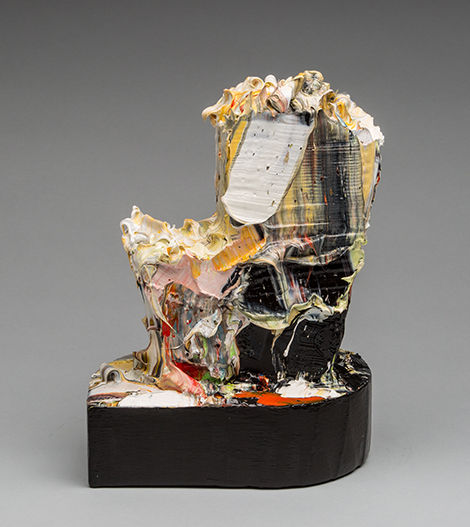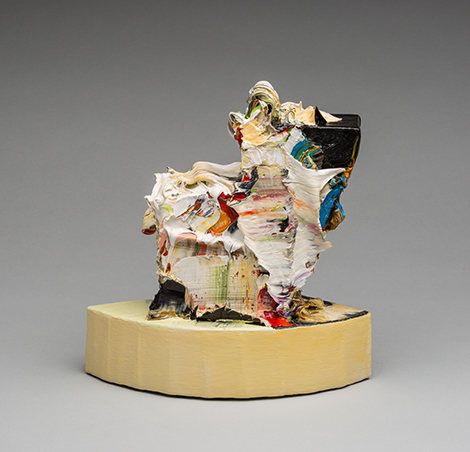Last fall Patricia Sweetow relocated to Oakland’s vibrant Uptown district, where Spun Smoke, her new venue, combines fine art with high-end, high-fire ceramics and a few skeins of her very own hand-spun, hand-dyed wool. Spun Smoke recently presented work by accomplished painter Cornelia Schulz.
In recent years Schulz has taken her sophisticated gestural abstractions down to a compact scale, and here followed an impulse to bring them off the wall entirely and into the realm of sculpture. Initial efforts were, apparently, unsuccessful, but persistence paid off; “Piece A Cake” offers the disingenuous suggestion that these small gems came easily. As well, their scale and shape could suggest an actual hunk of pastry—a deliberately disarming subterfuge.
Schulz presented nine works in oil on canvas on 3D wooden supports. The vertically-oriented, thickly-painted structures are all small in scale and rest upon—in fact, are bolted to—their bases. One of the most intriguing of this engaging and quirky bunch is Piece A Cake #5 (2015), sitting on a semi-circular hunk of vanilla-colored “pedestal.” It also resembles an animal—a sheep say, or a horse—the rounded edge of a black rectangular solid peeking out like a muzzle from a thick coating of white—edged with cerulean blue, black and a pale yellow ocher, and striped with a dizzying array of warm and cool hues and tones, cadmium red, orange, lime green. Thick overall, the paint is in some areas scraped down with a tool, leaving a pattern of shallow, regular grooves; in other areas, it is whipped into a frenzy, peaking and frothing into points like a stiff meringue.
References to Minimalism, strongly felt in the artist’s earlier shaped canvases that evoked groundbreaking works by Frank Stella and Elizabeth Murray, remain as a foil and grounding device, the firm and severe geometric structure undergirding the extravagant paint. If Stella achieved notoriety with an emphasis on flatness and his desire to draw our attention to the two-dimensionality of the picture plane, Schulz conversely wows us with the undeniable three-dimensionality of paint itself.

Cornelia Schulz, Piece A Cake #3, 2014, Courtesy Patricia Sweetow Gallery/Spun Smoke, photo credit: David Schmitz
Piece A Cake #3 (2014) sits atop a black teardrop shape. Drooping peaks of white trail onto the base, yet the opposite side of this “stroke” is black. Wavy forms alternate between suggesting water, frosting and tar. The profusion of complex, intricate brushwork like this belies any misconception one might initially have that these are “easy” works.
This mimicry of other substances playfully nods to the trompe l’oeil sculptural tradition, particularly strong in the Bay Area ceramics world, where clay performs a convincing job of imitating wood, paper or other materials, and is found in the work of artists such as Richard Shaw or, in a funkier incarnation, Robert Arneson. With the ascendancy of hybrid media, Schulz’s skillful pairing of the concerns of painting and sculpture is visually stunning and quite contemporary in feel, almost daring us to dismiss these works as too beautiful at times, and then subtly revealing their remarkable sophistication—and good taste.


